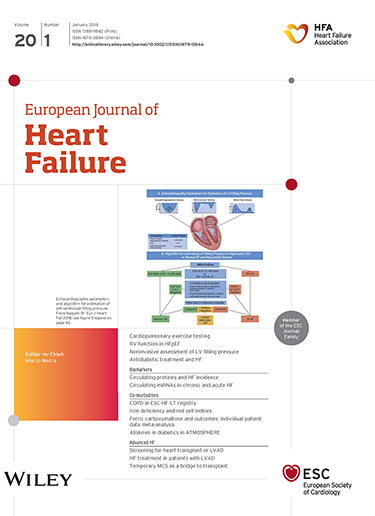蛋白尿作为心衰和其他心血管疾病的诊断标准和治疗靶点
IF 16.9
1区 医学
Q1 CARDIAC & CARDIOVASCULAR SYSTEMS
引用次数: 0
摘要
慢性肾脏疾病(CKD)、心力衰竭(HF)和其他心血管疾病(CVD)的高疾病负担和双向关系使得这些疾病需要早期诊断。虽然目前的筛查和检测方法是CKD和CVD指南推荐的,但它们在实践中的采用率很低。尿白蛋白与肌酐比值(uACR)被认为是CKD的诊断指标,也是CKD进展、HF和CVD结局的预后指标,因此尿白蛋白变化已被接受为肾脏和心血管终点的替代指标。此外,研究指南导向药物治疗的临床试验表明,uACR的降低伴随着心血管、心衰和其他CKD结局的风险降低。然而,uACR并没有在有肾脏和心脏疾病风险的患者中进行常规测量,其在检测、风险分层和预测模型方面的效用在常规临床实践中可能没有得到充分的认识。本文将讨论uACR筛查作为心脏和肾脏疾病诊断和风险评估方法的有效性和意义。本文章由计算机程序翻译,如有差异,请以英文原文为准。

Albuminuria as a diagnostic criterion and a therapeutic target in heart failure and other cardiovascular disease
The high disease burden and bidirectional relationship of chronic kidney disease (CKD), heart failure (HF) and other cardiovascular disease (CVD) necessitate the need for early diagnosis of these diseases. While current screening and detection methods are recommended by CKD and CVD guidelines, their adoption in practice is low. Urine albumin‐to‐creatinine ratio (uACR) is recognized as a diagnostic marker for CKD and a prognostic marker for CKD progression, HF and CVD outcomes, therefore albuminuria changes have been accepted as a surrogate outcome for kidney and cardiovascular endpoints. Furthermore, clinical trials investigating guideline‐directed medical therapies have shown that uACR reductions are accompanied by risk reductions for cardiovascular, HF and other CKD outcomes. However, uACR is not routinely measured in patients at risk of kidney and heart disease, and its utility for detection, risk stratification and prediction models may not be fully appreciated in routine clinical practice. This review will discuss the effectiveness and implications of uACR screening as a method for heart and kidney disease diagnosis and risk assessment.
求助全文
通过发布文献求助,成功后即可免费获取论文全文。
去求助
来源期刊

European Journal of Heart Failure
医学-心血管系统
CiteScore
27.30
自引率
11.50%
发文量
365
审稿时长
1 months
期刊介绍:
European Journal of Heart Failure is an international journal dedicated to advancing knowledge in the field of heart failure management. The journal publishes reviews and editorials aimed at improving understanding, prevention, investigation, and treatment of heart failure. It covers various disciplines such as molecular and cellular biology, pathology, physiology, electrophysiology, pharmacology, clinical sciences, social sciences, and population sciences. The journal welcomes submissions of manuscripts on basic, clinical, and population sciences, as well as original contributions on nursing, care of the elderly, primary care, health economics, and other related specialist fields. It is published monthly and has a readership that includes cardiologists, emergency room physicians, intensivists, internists, general physicians, cardiac nurses, diabetologists, epidemiologists, basic scientists focusing on cardiovascular research, and those working in rehabilitation. The journal is abstracted and indexed in various databases such as Academic Search, Embase, MEDLINE/PubMed, and Science Citation Index.
 求助内容:
求助内容: 应助结果提醒方式:
应助结果提醒方式:


